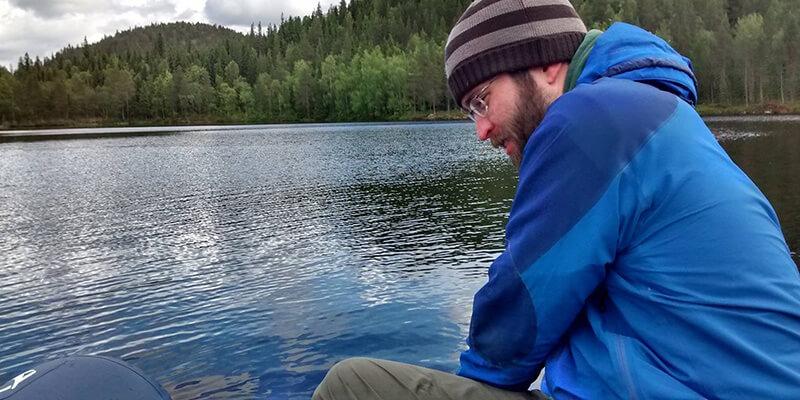As a postdoctoral associate at Umeå University in Sweden, Rubenstein School alum David Seekell (NR ’09) received a prestigious Wallenberg Fellowship in 2015 from the Knut and Alice Wallenberg Foundation, which invests in promising young researchers from all disciplines. Now an assistant professor of ecology at Umeå, he continues to pursue research in limnology and studies the impacts of rapid climate changes on Sweden’s boreal and arctic lakes.
David’s fellowship came with a $2 million research grant, which will support whole-ecosystem experiments to investigate the potential for tipping points, beyond which damage caused by climate change impacts is difficult to repair, in arctic and boreal lakes. Very few lake ecosystem studies of this magnitude exist in the world.
David’s interest in the study of ecosystems began as an undergraduate in the University of Vermont’s Rubenstein School of Environment and Natural Resources. As a first-year student, David, a native of Rhode Island, was captivated by NR 1 Natural History and Field Ecology taught by former Associate Professor Larry Forcier.
“Larry was key in the development of my thinking of how ecosystems work,” says David, who went on to earn his PhD in environmental science at the University of Virginia (UVA) in 2014, followed by postdoctoral studies of lake ecosystems at Umeå University. But, the important lessons extended beyond classroom work.
“Larry helped to build my confidence level in interacting with faculty and administration in academia. This comfort level was extremely beneficial later on as a doctoral student and as a postdoctoral associate when networking became critical to obtaining important professional development opportunities," adds David, who, with Larry's urging, applied to the National Science Foundation (NSF) Research Experiences for Undergraduates program. He spent a summer diving into ecological research at Cary Institute of Ecosystem Studies in Millbrook, New York.
Under the tutelage of Research Associate Jarlath O’Neil-Dunne, former Professor Austin Troy, and former adjunct faculty member Morgan Grove of the Spatial Analysis Laboratory in the School, David gained skills in GIS and produced an undergraduate project that his mentors encouraged him to publish.
“Jarlath’s GIS Practicum course was the best class I took as an undergraduate,” states David. “Jarlath taught me to solve problems by figuring out the questions first. That’s what being an independent researcher is all about – you have to be able to identify the novel and important questions first before going after the solutions.”
While a visiting PhD candidate with a NSF Nordic Research Opportunity graduate fellowship, David took his undergraduate project from the GIS class to Uppsala University in Sweden. There, he expanded the work to examine regional scale variability in biogeochemistry in lakes. He has since visited UVM to speak to students about his career path in lake studies at the bequest of Rubenstein School Associate Professor Jason Stockwell, director of the Rubenstein Ecosystem Science Center on the Lake Champlain waterfront.
David's growing connections with Swedish colleagues helped to propagate his appointments at Umeå University where he conducts his large-scale studies on degraded lake ecosystems, resulting from human-related climate change, land-use change, and pollution. When a lake ecosystem goes beyond a certain tipping point, this often manifests as harmful algal blooms or fisheries collapse.
This is what limnologists like David try to prevent. During graduate school, he studied fish populations in Peter and Paul Lakes in the Upper Peninsula of Michigan with colleagues at the University of Wisconsin-Madison, Cary Institute, and UVA. The research team developed and tested early warning indicators, such as specific variations in lake chlorophyll levels, that can signal a collapse in fish populations well before it happens.
David notes that lake productivity indicators are different in Sweden than in lakes in the United States, where nutrients, such as phosphorus and nitrogen, drive algae and fish populations dynamics. As in the United States, many changes in Sweden’s lakes are related to climate change. But in Sweden, the concern is for the increasingly brown color of the lakes’ water due to rising inputs of partially decomposed organic matter in the form of peat and vegetation running off the surrounding landscape.
“It’s all about water clarity and color and how much light penetrates. The water is brown as though it contains coffee grounds or tea leaves,” David says.
To learn more, he will push the lake ecosystems in Sweden to their tipping points by adding even more organic matter in large-scale experiments and investigate the impacts. He hopes to learn how brown the water can become before algae get too little light to grow and if lakes in the boreal zone respond differently than in the arctic or temperate zones. His results will have impacts for management of lakes throughout the world.
Announced this month, David has won the Science for Solutions Award from the American Geophysical Union, the world’s largest scientific society for earth and space sciences, in recognition of his application of fundamental earth science to help solve global problems.
